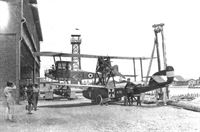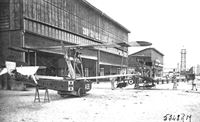
Описание
Страна: Германия
Год: 1917
Fighter
Варианты
- Hansa-Brandenburg - W.17 - 1917 - Германия
- Hansa-Brandenburg - W.18 / W.23 - 1917 - Германия
- В.Обухович, А.Никифоров Самолеты Первой Мировой войны
- O.Thetford, P.Gray German Aircraft of the First World War (Putnam)
- W.Green, G.Swanborough The Complete Book of Fighters
- J.Herris German Seaplane Fighters of WWI (A Centennial Perspective on Great War Airplanes 2)
- C.Owers Hansa-Brandenburg Aircraft of WWI Vol.2: Biplane Seaplanes (A Centennial Perspective on Great War Airplanes 18)
- M.Dusing German Aviation Industry in WWI. Volume 1 (A Centennial Perspective on Great War Airplanes 84)
- E.Hauke, W.Schroeder, B.Totschinger Die Flugzeuge der k.u.k. Luftfahrtruppe und Seeflieger 1914-1918
-
C.Owers - Hansa-Brandenburg Aircraft of WWI. Volume 2 - Biplane Seaplanes /Centennial Perspective/ (18)
The German prototype W18 before its Marine Number, 2138, was painted on the hull. The German Navy preferred floatplanes and no more W18s were supplied to Germany. Standard late-war naval camouflage was applied.
-
J.Davilla - Italian Aviation in the First World War. Vol.1: Operations /Centennial Perspective/ (73)
Brandenburg W.18 A.50., EF Stb MaschWart Eduard Trober, Seeflugstation Triest, November-December 1917
-
C.Owers - Hansa-Brandenburg Aircraft of WWI. Volume 2 - Biplane Seaplanes /Centennial Perspective/ (18)
Brandenburg W.18 A.60. was one of the first batch of W.18 aircraft powered by the 230 hp Hiero for the kuk Kriegsmarine. Was in service in the Adriatic for some 10 months from December 1917, until written off due to age.
-
E.Hauke, W.Schroeder, B.Totschinger - Die Flugzeuge der k.u.k. Luftfahrtruppe und Seeflieger 1914-1918
Hansa-Brandenburg W.18 A 68 Triest Juli 1918
-
E.Hauke, W.Schroeder, B.Totschinger - Die Flugzeuge der k.u.k. Luftfahrtruppe und Seeflieger 1914-1918
Hansa-Brandenburg W.18 A 71 Triest März 1918
-
C.Owers - Hansa-Brandenburg Aircraft of WWI. Volume 2 - Biplane Seaplanes /Centennial Perspective/ (18)
Brandenburg W.18 A.78. 'V' was powered by the 230 hp Hiero. Was accepted on 09.07.17. Serving with Banfield's squadron at Trieste, it was captured by the Italians on 4 May 1918 and was written off.
-
E.Hauke, W.Schroeder, B.Totschinger - Die Flugzeuge der k.u.k. Luftfahrtruppe und Seeflieger 1914-1918
Hansa-Brandenburg W.18 A 78 Triest Mai 1918
-
C.Owers - Hansa-Brandenburg Aircraft of WWI. Volume 2 - Biplane Seaplanes /Centennial Perspective/ (18)
Brandenburg W.18 A.89. The airframes for A.88 - A.96 were built in Germany and delivered without a motor or guns to the kuk Kriegsmarine.
-
C.Owers - Hansa-Brandenburg Aircraft of WWI. Volume 2 - Biplane Seaplanes /Centennial Perspective/ (18)
Brandenburg W.18 A.91. was captured by the Italians. It was one of the first batch of W.18 aircraft powered by the 230 hp Hiero for the kuk Kriegsmarine.
-
В.Обухович, А.Никифоров - Самолеты Первой Мировой войны
Ганза-Бранденбург K
-
C.Owers - Hansa-Brandenburg Aircraft of WWI. Volume 2 - Biplane Seaplanes /Centennial Perspective/ (18)
Developed from the CC, the W18 used conventional interplane struts, which weighed less than the star-struts of the CC. Only one was supplied to the German Navy, but fitted with two guns and either the 200 hp or 230 hp Hiero engine, it was a great success operating with the Austro-Hungarian Navy, which liked flying boats. Its Marine Number 2138 is chalked on the side of the fuselage. The machine has the late-war hexagonal camouflage painted on the hull turtledeck. Note the location of the twin machine guns.
-
J.Herris - German Seaplane Fighters of WWI /Centennial Perspective/ (2)
The German W18 had conventional wing struts, two guns, and the standard late-war German naval camouflage.
Produced in quantity for the Austro-Hungarian Navy, the Brandenburg W18 followed the CC into service. -
J.Herris - German Seaplane Fighters of WWI /Centennial Perspective/ (2)
The W18 had conventional wing struts, two guns, and the standard late-war German naval camouflage.
-
C.Owers - Hansa-Brandenburg Aircraft of WWI. Volume 2 - Biplane Seaplanes /Centennial Perspective/ (18)
This W.18 is in the hexagonal camouflage to wings and hull. It has a small unbalanced rudder. It may be MN 2138 but late production boats for Austro-Hungary were in this color scheme.
-
J.Herris - German Seaplane Fighters of WWI /Centennial Perspective/ (2)
An Austro-Hungarian naval fighter pilot readies for his next mission in W18 A.50. Note the location of the machine gun along the top longeron.
-
M.Dusing - German & Austro-Hungarian Aero Engines of WWI. Vol.3 /Centennial Perspective/ (66)
The Hansa-Brandenburg fighter was powered by a Hiero engine; both 200hp and 230 hp engines were used.
-
C.Owers - Hansa-Brandenburg Aircraft of WWI. Volume 2 - Biplane Seaplanes /Centennial Perspective/ (18)
A.52 was delivered in the German hexagon camouflage scheme; Puntisella, October 1917.
-
E.Hauke, W.Schroeder, B.Totschinger - Die Flugzeuge der k.u.k. Luftfahrtruppe und Seeflieger 1914-1918
Abwehrflugzeug A.52, Type Brandenburg W.18, Puntisella, Oktober 1917 nach der Abnahme, auf den Oberseiten deutsches Marinetarnschema mit regelmäßigen Sechsecken
Самолет A.52, тип Brandenburg W.18, Пунтиселла, октябрь 1917 г., после принятия, немецкий шестиугольный военно-морской камуфляж на верхних поверхностях -
E.Hauke, W.Schroeder, B.Totschinger - Die Flugzeuge der k.u.k. Luftfahrtruppe und Seeflieger 1914-1918
Austro-Hungarian W.18 serial A.71 in its launching cradle on the hardstand at Puntisella, January 1918. Sfr. Franz Pichl prepares for a sortie.
A.71 was an Austro-Hungarian Brandenburg W.18 seaplane fighter. The W.18 was a more powerful development of the CC. A.71 was one of 47 Brandenburg W.18s that served with the Austro-Hungarian Navy, which liked flying boats. Fitted with two guns and powered by a 230 hp Hiero engine, the W.18 served successfully in the Adriatic until the end of the war. The red/white/red Austro-Hungarian colors can be seen under the upper right wingtip.
Abwehrflugzeug A.71, Type Brandenburg W.18, Puntisella, Jänner 1918; Sfr Franz Pichl bereitet sich auf den Start vor. im Hintergrund steht der erbeutete Macchi M.5, versehen mit k.u.k. Markierungen und als Schulflugzeug verwendet
Самолет A.71, тип Brandenburg W.18, Пунтиселла, январь 1918 г .; Франц Пихль готовится к старту. На заднем плане - трофейный Macchi M.5, отмеченный символом k.u.k., использовался как учебно-тренировочный самолет -
C.Owers - Hansa-Brandenburg Aircraft of WWI. Volume 2 - Biplane Seaplanes /Centennial Perspective/ (18)
W.18 A.77 on the slipway.
-
C.Owers - Hansa-Brandenburg Aircraft of WWI. Volume 2 - Biplane Seaplanes /Centennial Perspective/ (18)
W.18 A77 leaving the slipway.
-
J.Davilla - Italian Aviation in the First World War. Vol.1: Operations /Centennial Perspective/ (73)
The Brandenburg W.18 was the best AH flying boat fighter. A.78 was captured by the Italians on 4 May 1918. The serial on the nose has been scraped off and remarked on the rear in a much smaller size. The "V" was the marking for Gottfried Banfield's squadron based at Trieste. According to Banfield the Roman numerals were used up as high as VII.
-
C.Owers - Hansa-Brandenburg Aircraft of WWI. Volume 2 - Biplane Seaplanes /Centennial Perspective/ (18)
W.18 fighters of Banfield's unit at Trieste, May 1918. Aircraft V (A78) and VI, appear to being readied for a sortie.
-
J.Herris - German Seaplane Fighters of WWI /Centennial Perspective/ (2)
This view of A.78. shows the red/white/red Austro-Hungarian markings under the upper wings and black outline to the iron cross insignia below the lower wings. Flying surfaces were clear-doped linen and the wood fuselage was stained. The old position of the serial shows as on the hull where it was scraped off.
-
R.Gentilli - Italian Aviation Units in the First World War. Vol.4 /Aeronaut/ (4)
The captured Austrian fighter A82; behind it an Ansaldo ISVA.
Другие самолёты на фотографии: Ansaldo ISVA - Италия - 1918
-
C.Owers - Hansa-Brandenburg Aircraft of WWI. Volume 2 - Biplane Seaplanes /Centennial Perspective/ (18)
Flieger Quartiermeister Reinhold Haschke (four victories) poses with A.89 at Gjenovics, July 1918.The Schwarzlose machine gun can be seen mounted alongside the cockpit.The cartridge ejection chute can be seen above the "8" of the serial. This was to catch shells and prevent them striking the pusher propeller. This W.18 has the upper wing striped red and white as well as the tailplane, otherwise it is in plain finish. The bombs are for show as the machine was not equipped to carry bombs.
-
J.Herris - German Seaplane Fighters of WWI /Centennial Perspective/ (2)
W18 A.91 in Italian hands displays damage to the rear and bow of the hull. The windows on the fairing in front of the cockpit are visible.
-
R.Gentilli - Italian Aviation Units in the First World War. Vol.4 /Aeronaut/ (4)
The captured Austrian fighter A91 in Venice; behind it there is an M.5 of the 260a Squadriglia, probably serialled 7289, showing the letters "Ja" that surely stood for Guido Jannello.
Другие самолёты на фотографии: Macchi M.5 / M.6 - Италия - 1917
-
C.Owers - Hansa-Brandenburg Aircraft of WWI. Volume 2 - Biplane Seaplanes /Centennial Perspective/ (18)
The remains of A68 in a wrecked aircraft dump.
-
W.Green, G.Swanborough - The Complete Book of Fighters
The W18 in production form with Hiero engine.
-
W.Green, G.Swanborough - The Complete Book of Fighters
The single prototype of the Brandenburg W 23.
-
C.Owers - Hansa-Brandenburg Aircraft of WWI. Volume 2 - Biplane Seaplanes /Centennial Perspective/ (18)
Brandenburg W.18 SVK Drawing
-
C.Owers - Hansa-Brandenburg Aircraft of WWI. Volume 2 - Biplane Seaplanes /Centennial Perspective/ (18)
Brandenburg W.23 SVK Drawing
-
C.Owers - Hansa-Brandenburg Aircraft of WWI. Volume 2 - Biplane Seaplanes /Centennial Perspective/ (18)
Brandenburg W.23 Factory Drawing
В.Обухович, А.Никифоров Самолеты Первой Мировой войны
Версия W 18 в основном отличалась коробкой крыльев: увеличился размах, законцовки крыльев были скруглены, стойки упростились, нижнее крыло получило небольшую стреловидность. Незначительно изменилась форма стабилизатора. Вооружение состояло из двух неподвижных пулеметов в фюзеляже. Вес самолета увеличился на 75 кг.
Описание:








































